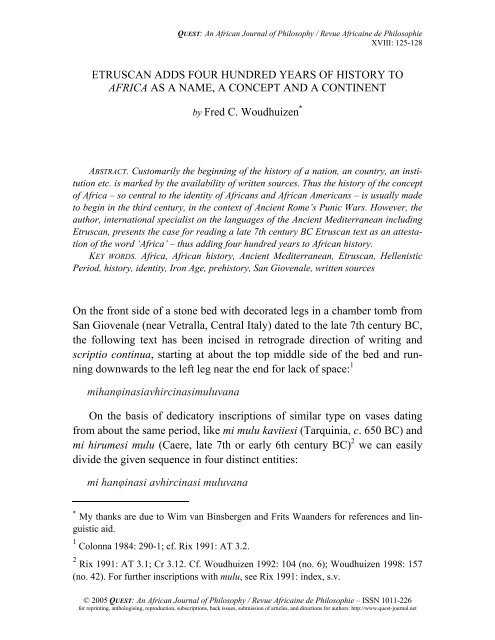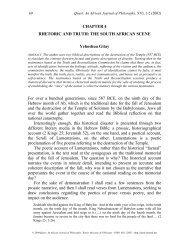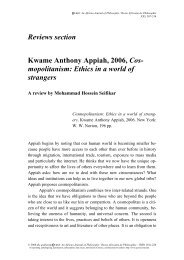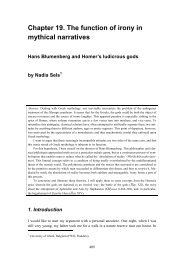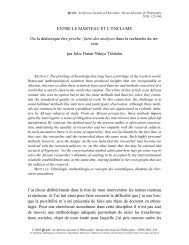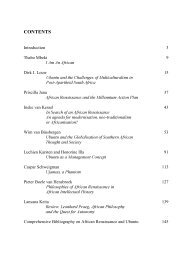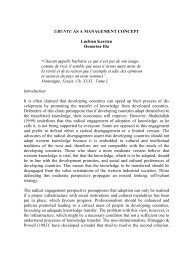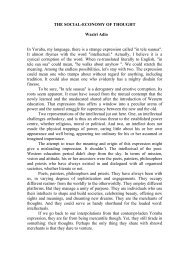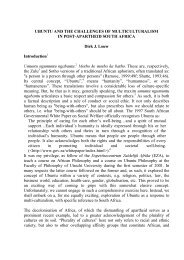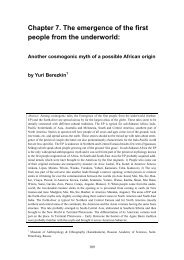obligation morale et developpement social - Quest-journal.net
obligation morale et developpement social - Quest-journal.net
obligation morale et developpement social - Quest-journal.net
You also want an ePaper? Increase the reach of your titles
YUMPU automatically turns print PDFs into web optimized ePapers that Google loves.
QUEST: An African Journal of Philosophy / Revue Africaine de Philosophie<br />
XVIII: 125-128<br />
ETRUSCAN ADDS FOUR HUNDRED YEARS OF HISTORY TO<br />
AFRICA AS A NAME, A CONCEPT AND A CONTINENT<br />
by Fred C. Woudhuizen *<br />
ABSTRACT. Customarily the beginning of the history of a nation, an country, an institution<br />
<strong>et</strong>c. is marked by the availability of written sources. Thus the history of the concept<br />
of Africa – so central to the identity of Africans and African Americans – is usually made<br />
to begin in the third century, in the context of Ancient Rome’s Punic Wars. However, the<br />
author, international specialist on the languages of the Ancient Mediterranean including<br />
Etruscan, presents the case for reading a late 7th century BC Etruscan text as an attestation<br />
of the word ‘Africa’ – thus adding four hundred years to African history.<br />
KEY WORDS. Africa, African history, Ancient Mediterranean, Etruscan, Hellenistic<br />
Period, history, identity, Iron Age, prehistory, San Giovenale, written sources<br />
On the front side of a stone bed with decorated legs in a chamber tomb from<br />
San Giovenale (near V<strong>et</strong>ralla, Central Italy) dated to the late 7th century BC,<br />
the following text has been incised in r<strong>et</strong>rograde direction of writing and<br />
scriptio continua, starting at about the top middle side of the bed and running<br />
downwards to the left leg near the end for lack of space: 1<br />
mihanφinasiavhircinasimuluvana<br />
On the basis of dedicatory inscriptions of similar type on vases dating<br />
from about the same period, like mi mulu kaviiesi (Tarquinia, c. 650 BC) and<br />
mi hirumesi mulu (Caere, late 7th or early 6th century BC) 2 we can easily<br />
divide the given sequence in four distinct entities:<br />
mi hanφinasi avhircinasi muluvana<br />
* My thanks are due to Wim van Binsbergen and Frits Waanders for references and lin-<br />
guistic aid.<br />
1 Colonna 1984: 290-1; cf. Rix 1991: AT 3.2.<br />
2 Rix 1991: AT 3.1; Cr 3.12. Cf. Woudhuizen 1992: 104 (no. 6); Woudhuizen 1998: 157<br />
(no. 42). For further inscriptions with mulu, see Rix 1991: index, s.v.<br />
© 2005 QUEST: An African Journal of Philosophy / Revue Africaine de Philosophie – ISSN 1011-226<br />
for reprinting, anthologising, reproduction, subscriptions, back issues, submission of articles, and directions for authors: http://www.quest-<strong>journal</strong>.n<strong>et</strong>
Fred C. Woudhuizen<br />
Of these four entities, the first, mi, is the nominative of the pronoun of<br />
the 1st person singular “I”, which characterizes archaic dedicatory inscriptions<br />
being usually conducted in the first person singular as if the object itself<br />
speaks to the reader (so-called “iscrizioni parlanti”). Next, the last word,<br />
muluvana, is obviously related with mulu of the given vase inscriptions and<br />
therefore likewise denotes the object being dedicated. Now, the root mulu-<br />
or muluva-, which is also present in the central verb of dedicatory inscriptions,<br />
muluvanike, muluvanece, <strong>et</strong>c., “(s)he has offered as a vow”, ultimately<br />
originates from Luwian hieroglyphic maluwa- “thank-offering”, derivations<br />
of which are attested for Sid<strong>et</strong>ic in form of malvam1a, corresponding to<br />
Greek kharistēria in a bilingual inscription, and Lydian in form of<br />
ml1ve1ndai1 (dative plural in -ai1), bearing reference to mobilia in the grave. 3<br />
What strikes us in the present form muluvana is the preservation of rootfinal<br />
-va- in like manner as in the related verb, which, in the light of the Luwian<br />
background, forms an integral part of the root and hence has been<br />
dropped in the abridged mulu. Furthermore, it is characterized by an additional<br />
element -na, which likely classifies it as a nominal or adjectival derivation<br />
in the same manner as śuthina or suthina “grave-gift” is derived from<br />
śuthi or suthi “grave”, in short as som<strong>et</strong>hing pertaining to the thank-offering.<br />
Finally, the two corresponding forms in the middle render the name of the<br />
deceased person for which the bed was intended, both elements of which<br />
show the adjectival genitive in -si, originating from Luwian -ašši-. 4 In sum,<br />
this leads us to the following translation:<br />
“I (am) the (…) pertaining to the thank-offering of Hanphinas Afircinas”<br />
As far as the name of the deceased person is concerned, the first element,<br />
hanφina-, recalls the family name or gentilicium hamφna- as attested for<br />
later inscriptions primarily from the region of Perugia. Contrary to the opinion<br />
of the editor of our inscription, Giovanni Colonna, however, I do not<br />
think that it actually constitutes the first name or praenomen, which would<br />
collide with the given comparative evidence, but rather maintain that the<br />
3 Woudhuizen 1992, s.v. mulveni.<br />
4 Woudhuizen 1992: 79; 81-2.<br />
126
Etruscan Adds Four Hundred Years of History to Africa<br />
latter is omitted. 5 This inference coincides with the fact that the second element<br />
of the name, avhircina-, is not a family name or gentilicium, but an<br />
<strong>et</strong>hnonym of similar type as tursikina- as attested for a dedicatory inscription<br />
on a gold fibula from Chiusi dating to the last quarter of the 7th century BC. 6<br />
The latter form shows the root tursi- “Etruscan” in combination with the<br />
element -kina-, which is paralleled for vestirikina-, and in variant form -<br />
cina- or -cena-, for katacina-, melacina-, p<strong>et</strong>icina-, and atacena-, laricena-,<br />
respectively. As rightly stipulated by Carlo de Simone, the morpheme -kina-,<br />
-cina- or -cena- probably bears testimony of Celtic adstrate influences on<br />
Etruscan, and therefore may likely be traced back to Proto-Indo-European<br />
*ģenh1- “to procreate” – a root frequently applied in kinship terms. 7 Accordingly,<br />
we are left with the residual element avhir-, which, as Colonna keenly<br />
observed, should be compared to the root of the family name afrcna- and<br />
afrce- (note that 7th century BC vh = later f) as recorded for the region of<br />
Chiusi, and as such actually confronts us with an unsuspectedly early reflex<br />
of the <strong>et</strong>hnic designation Africus, 8 based on the root Āfer “African” or Āfrī<br />
“an African.” 9<br />
To be more precise: our Etruscan inscription attests the <strong>et</strong>hnonym “African”,<br />
four hundred years before the earliest attestation of Afer (viz. as a cognomen<br />
of the Carthaginian born Publius Terentius Afer, a playwright in the<br />
160s BC) 10 or Africa 11 (used by the po<strong>et</strong> Ennius who lived from 239 to 169<br />
BC) in Latin! Given the fact 12 that in its earliest use Africa refers to the re-<br />
5 Colonna 1984: 291; cf. Rix 1991: Pe 1.42; Pe 1.43; Pe 1.143; Pe 1.619; Pe 1.1217; <strong>et</strong>c.<br />
For gentilicia in –na-, see Woudhuizen 1992: 81.<br />
6 Rix 1991: Cl 2.3. Cf. Woudhuizen 1992: 104 (no. 10).<br />
7 De Simone 1978; cf. Woudhuizen 1998: 141; 191.<br />
8 Colonna 1984: 291 (“insosp<strong>et</strong>tata antichità”); cf. Rix 1991: Cl 1.2593; Cl 1.558; Cl<br />
1.2437; Cl 1.550; Cl 1.1321.<br />
9 Lewis & Short 1975, s.v. Āfer.<br />
10 Hornblower & Spawforth 1996, s.v. Terence.<br />
11 Vahlen 1903: 55 (Annalium 310); 205 (Saturarum 11); cf. Hornblower & Spawforth<br />
1996, s.v. Ennius.<br />
12 Ashmore 1961, s.v. Africa, Roman. Cf. the surname Africānus attributed to P. Cornelius<br />
Scipio major after the defeat of Hannibal at Zama in 201 BC, and to P. Cornelius<br />
127
Fred C. Woudhuizen<br />
gion of Carthage, it may reasonably be inferred that our African buried in the<br />
chamber tomb at San Giovenale originated from the latter region, with<br />
which Etruria was in close contact from the very beginning of the Etruscan<br />
civilization during the late 8th and early 7th century BC onwards. 13 However,<br />
the Etruscan nature of his family name, showing the characteristic element<br />
-na-, should warn us against oversimplified conclusions: the person in<br />
question may well have been fully Etruscanized already during his lif<strong>et</strong>ime.<br />
Bibliography<br />
Ashmore, H.S., 1961, Encyclopaedia Brittanica: A new survey of universal knowledge. Chicago-<br />
London-Toronto.<br />
Colonna, Giovanni, 1984, REE 15. Studi Etruschi 52. pp. 290-291.<br />
Hornblower, Simon, & Spawforth, Antony, 1996 The Oxford Classical Dictionary (3rd ed.).<br />
Oxford-New York: Oxford University Press.<br />
Lewis, Charlton T., & Short, Charles, 1975, A Latin Dictionary. Oxford: At the Clarendon Press.<br />
Rix, Helmut, & alii, 1991, Etruskische Texte, Editio minor. I Einleitung, Konkordanz, Indice. II<br />
Texte. Tübingen: Günter Narr Verlag.<br />
Simone, Carlo de, 1978, ‘Un nuovo gentilizio Etrusco di Orvi<strong>et</strong>o (KATACINA) e la cronologia<br />
della pen<strong>et</strong>razione Celtica (Gallica) in Italia’. Parola del Passato 33. pp. 370-395.<br />
Vahlen, Iohannes, 1903, Ennianae Poesis Reliquiae. Lipsiae: In Aedibus B.G. Teubneri.<br />
Woudhuizen, Fred C., 1992, Linguistica Tyrrhenica, A Compendium of Recent Results in<br />
Etruscan Linguistics. Amsterdam: Gieben<br />
Woudhuizen, Fred C., 1998, Linguistica Tyrrhenica II, The Etruscan Liturgical Calendar from<br />
Capua, Addenda <strong>et</strong> Corrigenda ad Volume I. Amsterdam: Gieben.<br />
Scipio Aemilianus minor after the destruction of Carthage in 146 BC. Note also that the<br />
Roman province Africa, later Africa v<strong>et</strong>us, consists of the region of Carthage.<br />
13 One may think in this connection of the mythical visit of Aeneas on his trip from Troy<br />
to Latium to the Carthaginian queen Dido, considering the fact that Aeneas is not only a<br />
Roman hero, but also an Etruscan cult figure. Archaeologically, the relations of Etruria<br />
with Carthage are reflected in the attestation of Etruscan bucchero in Carthage during the<br />
period of 630 to 580 BC, whereas epigraphically they are further underlined by an Etruscan<br />
inscription on an ivory plaque found at Carthage, dating from the 6th century BC<br />
(Rix 1991: Af 3.1); historically, finally, the Etrusco-Carthaginian alliance against the<br />
Phokaians at Alalia also in the 6th century BC may serve as a telling example.<br />
128


